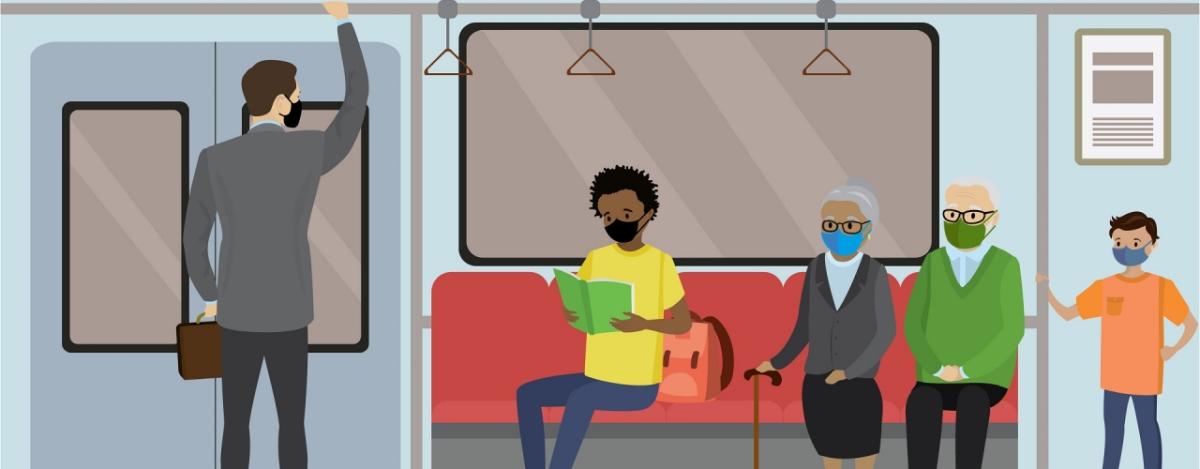Planning for Transit in the New Normal Post-COVID-19
Transit agencies face uncertainties as they anticipate what services and investments make sense for the other side of recovery. Fortunately, planners have tools to help make informed decisions.

by Donald Emerson, Senior Vice President
Transit was significantly impacted by the COVID-19 pandemic. As the economy was shut down and people were told to shelter at home, transit ridership dropped and fares and other sources of revenues declined, in some cases precipitously.
To the credit of dedicated transit workers who kept the systems operating throughout the pandemic, transit demonstrated that it could continue providing the public with a vital service, transporting essential workers and others to jobs, medical care, grocery stores and other destinations.
Early in the pandemic, transit agencies understandably focused their attention on the immediate present and the near-term recovery. Transit services were cut as ridership dropped, and agencies had to be very flexible in deciding what level of service to retain and restore as the economy was reopened.
Now, many transit agencies are looking beyond the pandemic, reviewing and updating their plans and programs to reflect anticipated changes in travel demand while factoring available funds into the equation. Service planners are trying to anticipate the transit routes and headways that will make sense “on the other side” of the recovery. While capital project planning and programming continues, some agencies are reassessing project priorities, scopes and phasing to ensure they are targeting their limited budgets in the right areas.
Preparing for the Third Stage
The pandemic and its aftermath are shaping up to have three stages: (1) COVID-19 shutdown, (2) reopening and recovery, and (3) the “new normal”.
Stage 3 conditions will occur when life returns to a relatively stable equilibrium – the economy is functioning, unemployment levels have dropped and people are reasonably confident that they can resume normal activity and feel safe without substantial fear of contracting COVID-19.
The conditions that will exist as the country and the world enter the “new normal” are very uncertain. Some expect that habits and trends that existed prior to the pandemic will reassert themselves, while others anticipate lasting changes in lifestyle and travel behavior that will affect transit. Others believe the pre-pandemic conditions were not ideal, and that recovery offers an opportunity to create a new normal that is better than what existed before.
Fortunately, transit planners have tools and data to help their agencies make informed decisions on future service offerings and capital investments even as the many uncertainties persist.
Data and AnalyticsTransit planning and decision making are driven by data and metrics. Planners rely heavily on population, employment, ridership and other data to generate the forecasts that are the foundation for transit plans, programs and projects.
Unless one believes that the COVID pandemic is a short-term aberration and that past trends will reassert themselves in time, past forecasts do not appear to provide a solid foundation for plans, programs and projects moving forward.
Today’s planners are blessed with access to a wealth of data collected in real time and available at little cost compared with its potential value. While current data cannot tell us how quickly the new normal will arrive – or what its characteristics will be – it does offer a sense of trends, such as the amount of travel taking place, and where and when those trips are on the system by time of day.
Transit agencies data on transit ridership can be augmented by real time information on travel derived from cell phones. Data on employment trends within a transit agency’s service area can also serve as a leading indicator of transit demand.
Significant research is also available on travel behavior following previous disruptions and the propensity of workers to telecommute long term. In addition, polling and surveys are being used to gather data on people’s anticipated behavioral changes.
Transit agencies planning for recovery and the subsequent new normal may benefit from gathering and considering a broader mix of data. There may be benefit in monitoring incidents of the virus in their community, the pace of economic recovery and evolving local policies on reopening.
PartnershipsSome transit agencies have benefitted from partnering with state and local health agencies, chambers of commerce and others to share data and coordinate plans for reopening.
Such coordination can help a transit agency understand the incidence of illnesses in their service area, the pace of economic recovery, and anticipate ridership impact when university students return to campus. Collaboration also helps other entities understand how and when transit service will be restored.
Planning for the new normal may also offer opportunities to establish new private sector partnerships or build upon existing ones.
There may be benefits for state and local agencies to contribute to a single shared regional dashboard that would help transit, health, and economic development entities that are tracking the rate of recovery and developing coordinated recovery plans.
Visioning
We are seeing an overwhelming number of advocates for initiatives and actions that ensure the new normal is better than old normal. Visioning is a tool used to develop a consensus of characteristics that will result in a safer, more desirable future.
By engaging in a thoughtful process of visioning with a wide range of stakeholders, transit agencies can be part of state and local decision-making processes that shape future outcomes for the better and address problems like climate change, resiliency and inequality.
During the pandemic, some transit agencies advanced low-cost projects – like bus only lanes – to enhance service and efficiency. Other agencies have achieved efficiencies by consolidating bus routes and stops, converting fixed route to on-demand service, and rethinking fare policies. These are ideas that were essential during the pandemic, but these practices could have far-reaching benefits long after the crisis has subsided.
Architects are reimagining transit facilities to be cleaner based on both active and passive design. They envision transit centers as healthy hubs featuring air filtering, touchless robotics, materials that impede microbial growth and station passageways in which passenger clothing is sanitized.
Scenario PlanningIn times of uncertainty, scenario planning can be a useful tool to test the impact of alternative assumptions about the future.
Scenario planning could include different timelines for the arrival of the new normal, as well as differing assumptions about land use, travel behavior, economic activity and funding availability.
“Alternative future” and “What if?” scenarios offer a more robust approach to planning than is possible using traditional single-point forecasts based upon assumptions that may or may not occur. This helps enhance our understanding of possibilities and risks.
Stakeholder Engagement
Transit agencies have had frequent communications with their customers and other stakeholders during Stages 1 and 2. They have made extensive and effective use of their websites, social media and the press to disseminate information on service changes and cleaning protocols.
Transit planning for the new normal will rely upon active and consistent stakeholder involvement. In May 2020, the Federal Transit Administration held a listening session to identify project planning challenges transit agencies were facing in the midst of the shutdown. Public involvement was mentioned by several participants as one of their toughest challenges. Virtual meetings and surveys are now commonplace and have become effective tools for gathering information and soliciting input on plans and projects.
Engaging with members of the community who lack smart phones or internet access has been another challenge. To ensure inclusivity for all who are interested in participating, a recent WSP white paper suggests supplementing online engagement with traditional communication methods, such as direct mail, utility bill inserts, telephone banking and public access television.
Anticipating the FutureA new normal will eventually arrive that will differ from the pre-COVID-19 world in ways that we can only speculate about now. But planners are trained to think about and anticipate the future … and these are skills and tools that will be critical for dealing with uncertainty and adapting to a changing transit landscape.
Transit agencies that apply strategic thinking, rely on the wealth of available data, develop and build upon partnerships, and apply good planning tools have an opportunity to not only survive the pandemic but also to help shape a better future.
Emerson is the author of “Planning for Transit in the New Normal Post-Covid-19,” a WSP white-paper describing and offering examples of how transit planners are dealing with current uncertainties about the conditions and travel behaviors that will exist once the new normal arrives.
[To subscribe to Insights, contact the editorial staff at insights@wsp.com.]

